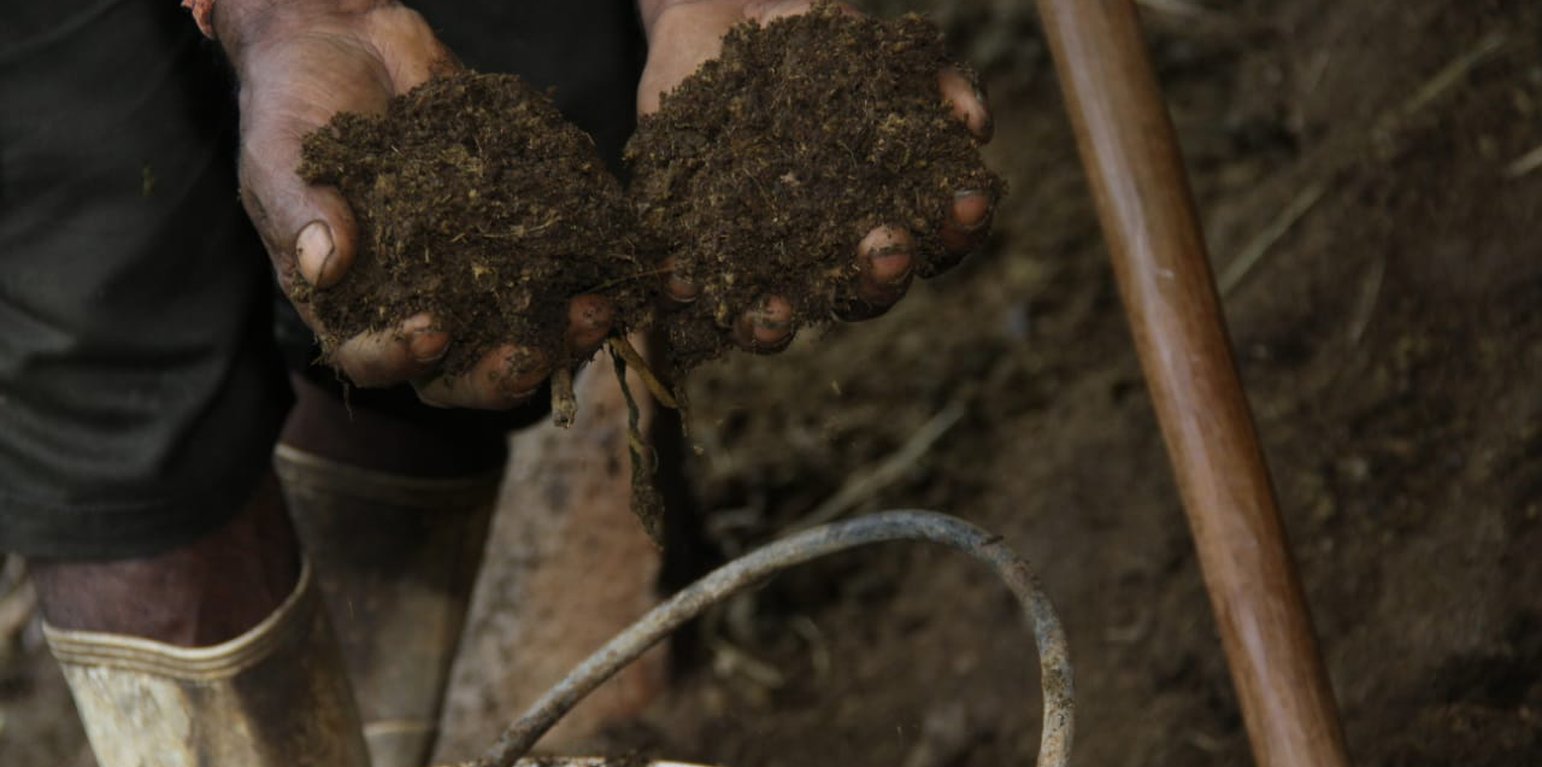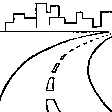Crop-livestock integration to enhance soil productivity
(ศรีลังกา)
คำอธิบาย
Crop-livestock integration improves nutrient circularity and soil productivity: solid and liquid organic fertilizers prepared from cow manure are incorporated to soil or sprayed on leaves of vegetables and tea.
Dairy cattle farming is common in the Dolluwa area of the central province of Sri Lanka. Farmers typically have 3-4 cows on about 2-3 hectares for both milk consumption and sales. The landowner interviewed did not formerly adhere to best practices: cows were grazed in woodlands, and water and supplementary feed were not provided as needed. Housing was inadequate. Farm waste wasn’t properly recycled. The farm is located on steep land without adequate soil conservation for annual crops and tea. There was heavy dependence on chemical fertilizer. As a consequence, milk production was below average and crop yields had declined. Besides, there was reservoir pollution due to effluent washed downslope.
New technology was developed to increase milk and crop production by integrating animal–crop management strategies while enhancing nutrient circularity within the farm, and improving soil productivity and environmental quality.
The landowner was first enrolled in the Rehabilitation of Degraded Agricultural Land Project (RDALP) of the UN’s FAO in 2018. The first priority was soil conservation for the steep areas under tea. SLM practices thus combined contour cropping and bunding. Following this, an integrated crop-livestock system was initiated. The RDALP and Fonterra Pvt. Ltd. helped the landowner to build a modern cowshed with infrastructure to provide feed and water. Thereafter, cows were stall-fed: grazing was completely stopped. Cow manure is collected and stored in heaps for 2-3 weeks before incorporating into soils. In the same shed, compost is prepared by mixing manure with crop residues and kitchen/ homegarden waste. Cattle urine and wastewater is directed to a cement tank where it is mixed with specific types of leaves; it is fermented and applied as liquid fertilizer and biopesticide. Manure is used mainly for fast-growing vegetables, while compost is applied to annuals, particularly at planting, and to tea once every three months. Liquid fertilizer is applied to tea seven days before harvesting.
This package requires adequate land for a cattle shed, and for a recycling system to prepare compost and liquid fertilizers. In addition, there must be enough labour for the whole process. The key inputs include materials for the shed, associated infrastructure, and a sprayer to apply liquid fertilizers.
The major benefit is recycling waste to generate useful products – while ensuring circularity of nutrients between crop and animal production systems: thus supporting a “bioeconomy”. Soil conservation practices and the nutrient sources described have improved soil fertility and productivity for overall sustainability. Milk yields have more than doubled, and the tea harvest more than trebled.
(1) Where is the Technology applied?
On steep terrain: tea is cultivated lower down and there are reservoirs in the valley.
(2) What are the purposes/ functions?
•Provide food security
•Increase efficiency of livestock production
•Promote overall nutrient cycling
•Partially substitute chemical fertilizers and pesticides with organic manure
•Generate high-quality organic manure and compost to improve soil fertility
•Control contamination of river water
(3) What are the benefits/ impacts of the Technology?
•Reduced susceptibility of crops to pests/ diseases
•Improved quality of food and water
•Slowed land degradation and restored soil fertility
•Reduced risks
•Economically feasible and rapid impact
(4) What do land users like/
•Reduced risk
•Increased income
•Reduction in cost of production
(5) ...dislike
•Damage to crops by wild animals.
•Higher cost for dairy farming (feed)
สถานที่
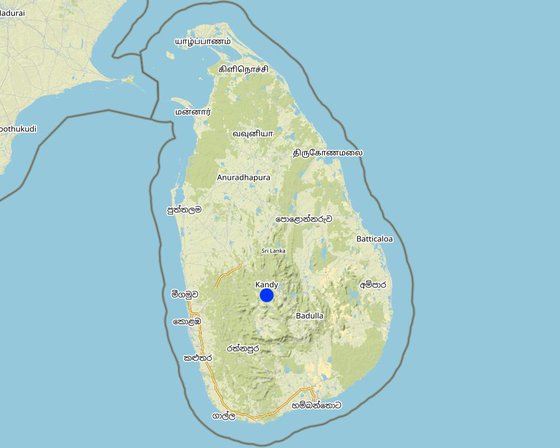
สถานที่: Dolluwa, Central province, ศรีลังกา
ตำนวนการวิเคราะห์เทคโนโลยี: พื้นที่เดี่ยว
ตำแหน่งทางภูมิศาสตร์ของสถานที่ที่ถูกเลือ
การเผยแพร่ของเทคโนโลยี: ใช้ ณ จุดที่เฉพาะเจาะจงหรือเน้นไปยังบริเวณพื้นที่ขนาดเล็ก
In a permanently protected area?: ไม่ใช่
วันที่ในการดำเนินการ: 2019; น้อยกว่า 10 ปี (ไม่นานนี้)
ประเภทของการแนะนำ
-
ด้วยการริเริ่มของผู้ใช้ที่ดินเอง
-
เป็นส่วนหนึ่งของระบบแบบดั้งเดิมที่ทำก้นอยู่ (> 50 ปี)
-
ในช่วงการทดลองหรือการทำวิจัย
-
ทางโครงการหรือจากภายนอก
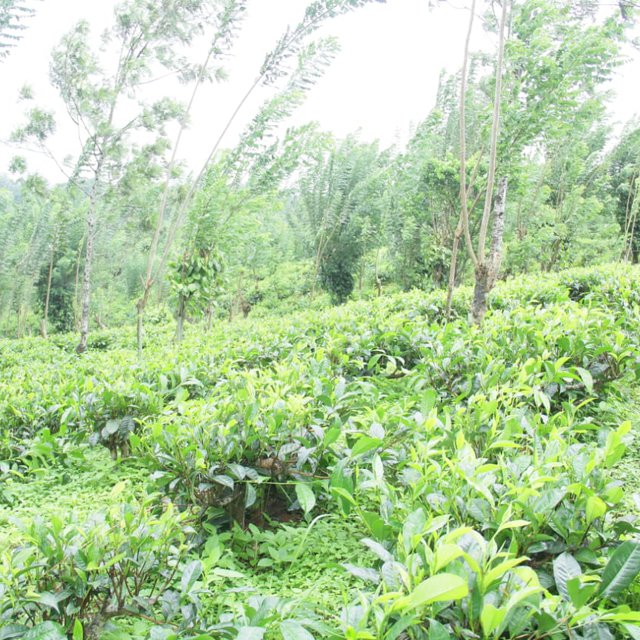
Tea cultivation on the lower part of the slope (Nimal Gunasena)
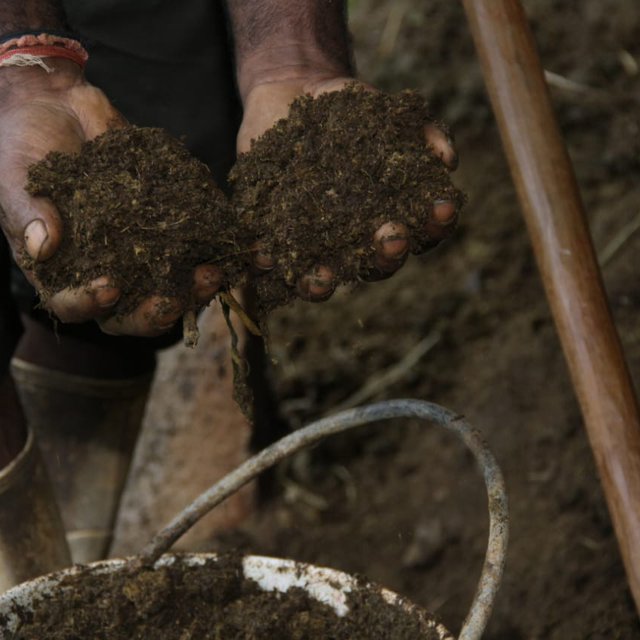
Compost preparation (Nimal Gunasena)
จุดประสงค์หลัก
-
ปรับปรุงการผลิตให้ดีขึ้น
-
ลด ป้องกัน ฟื้นฟู การเสื่อมโทรมของที่ดิน
-
อนุรักษ์ระบบนิเวศน์
-
ป้องกันพื้นที่ลุ่มน้ำ/บริเวณท้ายน้ำ โดยร่วมกับเทคโนโลยีอื่นๆ
-
รักษาสภาพหรือปรับปรุงความหลากหลายทางชีวภาพ
-
ลดความเสี่ยงของภัยพิบัติ
-
ปรับตัวเข้ากับการเปลี่ยนแปลงภูมิอากาศของโลก สภาพภูมิอากาศที่รุนแรงและผลกระทบ
-
ชะลอการเปลี่ยนแปลงภูมิอากาศของโลกและผลกระทบ
-
สร้างผลกระทบทางด้านเศรษฐกิจที่เป็นประโยชน์
-
สร้างผลกระทบทางด้านสังคมที่เป็นประโยชน์
การใช้ที่ดิน
Land use mixed within the same land unit: ใช่ - Agro-pastoralism (incl. integrated crop-livestock)
-
พื้นที่ปลูกพืช
- การปลูกพืชล้มลุกอายุปีเดียว: cereals - maize, flower crops, legumes and pulses - beans, medicinal/ aromatic/ pesticidal plants and herbs, root/tuber crops - sweet potatoes, yams, taro/cocoyam, other, root/tuber crops - cassava, root/tuber crops - potatoes, vegetables - leafy vegetables (salads, cabbage, spinach, other), vegetables - mushrooms and truffles, vegetables - other, vegetables - root vegetables (carrots, onions, beet, other). Cropping system: Continuous vegetables
- การปลูกพืชยืนต้นที่ไม่มีเนื้อไม้ : areca, banana/plantain/abaca, flower crops - perennial, herbs, chili, capsicum, medicinal, aromatic, pesticidal plants - perennial
- การปลูกไม้ยืนต้น ไม้พุ่ม: avocado, cacao, coconut (fruit, coir, leaves, etc.), coffee, shade grown, mango, mangosteen, guava, papaya, tea
จำนวนของฤดูเพาะปลูกต่อปี: 3
Is intercropping practiced? ใช่
Is crop rotation practiced? ใช่
-
ป่า/พื้นที่ทำไม้
- ป่ากึ่งธรรมชาติ / พื้นที่ทำไม้
Tree types (mixed deciduous/ evergreen): n.a.
ผลิตภัณฑ์และบริการ: ไม้ซุง, ไม้ที่นำมาทำเป็นเชื้อเพลิง, ผลไม้และถั่ว, ผลิตภัณฑ์อื่น ๆ จากป่า, การอนุรักษ์ / ป้องกันธรรมชาติ, การป้องกันภัยธรรมชาติ
-
การตั้งถิ่นฐาน โครงสร้างพื้นฐาน - การตั้งถิ่นฐาน ตึกอาคาร, พลังงาน ท่อส่งก๊าซธรรมชาติ สายส่งไฟฟ้า
ข้อสังเกต: cattle shed and compost shed are introduced through technology as settlements
pipelines are used for reove effluents from the farm
การใช้น้ำ
-
จากน้ำฝน
-
น้ำฝนร่วมกับการชลประทาน
-
การชลประทานแบบเต็มรูปแบบ
ความมุ่งหมายที่เกี่ยวข้องกับการเสื่อมโทรมของที่ดิน
-
ป้องกันความเสื่อมโทรมของที่ดิน
-
ลดความเสื่อมโทรมของดิน
-
ฟื้นฟูบำบัดที่ดินที่เสื่อมโทรมลงอย่างมาก
-
ปรับตัวกับสภาพความเสื่อมโทรมของที่ดิน
-
ไม่สามารถใช้ได้
ที่อยู่ของการเสื่อมโทรม
-
การกัดกร่อนของดินโดยน้ำ - Wt (Loss of topsoil): การสูญเสียดินชั้นบนหรือการกัดกร่อนที่ผิวดิน , Wo (Offsite degradation): ผลกระทบนอกพื้นที่
-
การเสื่อมโทรมของดินทางด้านเคมี - Cn (Fertility decline): ความอุดมสมบูรณ์และปริมาณอินทรียวัตถุในดินถูกทำให้ลดลงไป (ไม่ได้เกิดจากสาเหตุการกัดกร่อน)
-
การเสื่อมโทรมของน้ำ - Hp (Decline of surface water quality): การลดลงของคุณภาพน้ำที่ผิวดิน
กลุ่ม SLM
-
การจัดการปลูกพืชร่วมกับปศุสัตว์
-
การจัดการความอุดมสมบรูณ์ของดินแบบผสมผสาน
-
การจัดการของเสีย / การจัดการน้ำเสีย
มาตรการ SLM
-
มาตรการจัดการพืช - A1: พืช/สิ่งปกคลุมดิน, A2: อินทรียวัตถุในดิน/ความอุดมสมบูรณ์ในดิน, A3: การรักษาหน้าดิน (A 3.2: Reduced tillage (> 30% soil cover)), A6: Residue management (A 6.4: retained)
-
มาตรการอนุรักษ์ด้วยวิธีพืช - V1: ต้นไม้และพุ่มไม้คลุมดิน
-
มาตรการอนุรักษ์ด้วยโครงสร้าง - S2: ทำนบ เขื่อนดิน, S3: Graded ditches, channels, waterways, S6: กำแพง สิ่งกีดขวาง รั้วไม้ รั้วต่างๆ, S8: การสุขาภิบาลหรือโครงสร้างเกี่ยวกับน้ำเสีย, S9: ที่พักพิงสำหรับพืชและสัตว์, S11: อื่น ๆ
-
มาตรการอนุรักษ์ด้วยการจัดการ - M2: การเปลี่ยนแปลงของการจัดการหรือระดับความเข้มข้น, M3: การวางผังตามสิ่งแวดล้อมทางธรรมชาติและสิ่งแวดล้อมของมนุษย์, M6: การจัดการของเสีย (การทำ รีไซเคิล การเอากลับมาใช้ใหม่หรือการลดปริมาณ)
แบบแปลนทางเทคนิค
ข้อมูลจำเพาะด้านเทคนิค
None
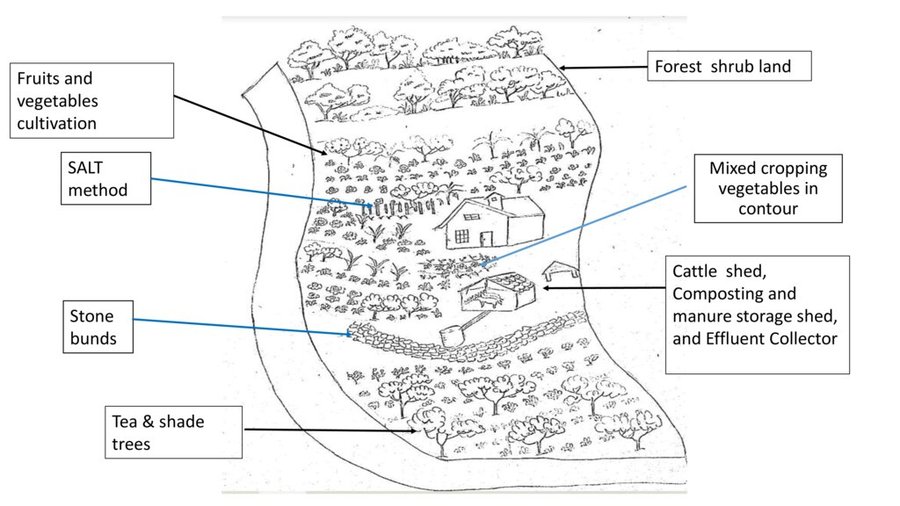
Author: R.M.S.K. Rathnayaka
การจัดตั้งและการบำรุงรักษา: กิจกรรม ปัจจัยและค่าใช้จ่าย
การคำนวนต้นทุนและค่าใช้จ่าย
- ค่าใช้จ่ายถูกคำนวน ต่อพื้นที่ที่ใช้เทคโนโลยี (หน่วยของขนาดและพื้นที่: 3.5 acreตัวแปลงค่าจาก 1 เฮกตาร์ = 1 hectare = 2.47 acres)
- สกุลเงินที่ใช้คำนวณค่าใช้จ่าย Sri Lankan Rupees
- อัตราแลกเปลี่ยน (ไปเป็นดอลลาร์สหรัฐ) คือ 1 ดอลลาร์สหรัฐ = 330.13 Sri Lankan Rupees
- ค่าจ้างเฉลี่ยในการจ้างแรงงานต่อวันคือ 900.00 Sri Lankan Rupees
ปัจจัยที่สำคัญที่สุดที่มีผลต่อค่าใช้จ่าย
The cost involved in intensive labour is higher than for inputs on a daily basis
กิจกรรมเพื่อการจัดตั้ง
-
Establishment of soil conservation measures (ช่วงระยะเวลา/ความถี่: Before rainy season)
-
Establishment of cattle shed (ช่วงระยะเวลา/ความถี่: After establishment of soil conservation measures)
-
Establishment of compost shed (ช่วงระยะเวลา/ความถี่: Before rainy season)
-
Establishment farm waste disposal system (ช่วงระยะเวลา/ความถี่: After establishment of compost shed)
-
Planting crops (ช่วงระยะเวลา/ความถี่: With the onset of rain)
-
Application of compost (ช่วงระยะเวลา/ความถี่: At and after planting crops)
-
Foliar application of liquid fertilizers (ช่วงระยะเวลา/ความถี่: After planting crops)
ปัจจัยและค่าใช้จ่ายของการจัดตั้ง (per 3.5 acre)
| ปัจจัยนำเข้า |
หน่วย |
ปริมาณ |
ค่าใช้จ่ายต่อหน่วย (Sri Lankan Rupees) |
ค่าใช้จ่ายทั้งหมดต่อปัจจัยนำเข้า (Sri Lankan Rupees) |
%ของค่าใช้จ่ายที่ก่อให้เกิดขึ้นโดยผู้ใช้ที่ดิน |
|
แรงงาน
|
| Establishment of cattle shed |
person days |
7.0 |
4400.0 |
30800.0 |
100.0 |
| Establishment of compost shed |
person days |
6.0 |
2000.0 |
12000.0 |
100.0 |
| Establishment of disposal system |
person days |
2.0 |
1200.0 |
2400.0 |
100.0 |
| Prepearation of Stone bunds |
person days |
5.0 |
1000.0 |
5000.0 |
15.0 |
|
อุปกรณ์
|
| Establishment of 'SALT' method (combined SLM measures on slopes) |
person days |
5.0 |
1000.0 |
5000.0 |
15.0 |
|
วัสดุด้านพืช
|
| Vegetable seeds |
gram |
10.0 |
100.0 |
1000.0 |
100.0 |
| Gliricidia stalks |
1 stalk |
1000.0 |
3.0 |
3000.0 |
100.0 |
|
ปุ๋ยและสารฆ่า/ยับยั้งการเจริญเติบโตของสิ่งมีชีวิต (ไบโอไซด์)
|
| Compost |
1 bag |
25.0 |
125.0 |
3125.0 |
100.0 |
| Cattle manure |
1 bag |
25.0 |
125.0 |
3125.0 |
100.0 |
|
วัสดุสำหรับก่อสร้าง
|
| Establishment of cattle shed (roofing sheets, bricks, cement, sand..) |
unit |
1.0 |
118645.0 |
118645.0 |
16.0 |
| Establishment of compost preparation unit (roofing sheets, bricks, cement, sand..) |
unit |
1.0 |
34560.0 |
34560.0 |
15.0 |
| Establishment of liquid waste disposal system (roofing sheets, cement, sand..) |
unit |
1.0 |
16500.0 |
16500.0 |
40.0 |
| Large bins to collect liquid waste |
|
2.0 |
4500.0 |
9000.0 |
100.0 |
|
อื่น ๆ
|
| cable |
|
18.0 |
890.0 |
16020.0 |
|
| ค่าใช้จ่ายทั้งหมดของการจัดตั้งเทคโนโลยี |
260'175.0 |
|
| Total costs for establishment of the Technology in USD |
788.1 |
|
กิจกรรมสำหรับการบำรุงรักษา
-
Cleaning of drains in tea land - removing weeds and sediments (ช่วงระยะเวลา/ความถี่: After rainy season (twice a year))
-
Lopping of trees established as SALT and shade trees of tea land (ช่วงระยะเวลา/ความถี่: Before land preparation in each growing season)
-
Minor renovations of cattle shed and composing unit (ช่วงระยะเวลา/ความถี่: Once in a year)
-
Replace bins used to collect liquid waste (ช่วงระยะเวลา/ความถี่: Whenever broken)
ปัจจัยและค่าใช้จ่ายของการบำรุงรักษา (per 3.5 acre)
| ปัจจัยนำเข้า |
หน่วย |
ปริมาณ |
ค่าใช้จ่ายต่อหน่วย (Sri Lankan Rupees) |
ค่าใช้จ่ายทั้งหมดต่อปัจจัยนำเข้า (Sri Lankan Rupees) |
%ของค่าใช้จ่ายที่ก่อให้เกิดขึ้นโดยผู้ใช้ที่ดิน |
|
แรงงาน
|
| Cleaning of drains in tea land - removing weeds and sediments |
Person days |
6.0 |
1200.0 |
7200.0 |
100.0 |
| Lopping of trees established as SALT and shade trees of tea land |
Person days |
4.0 |
1200.0 |
4800.0 |
100.0 |
| Minor renovations of cattle shed and composing unit |
Person days |
3.0 |
1200.0 |
3600.0 |
100.0 |
|
ปุ๋ยและสารฆ่า/ยับยั้งการเจริญเติบโตของสิ่งมีชีวิต (ไบโอไซด์)
|
| Application of compost and cattle manure |
bag |
25.0 |
125.0 |
3125.0 |
100.0 |
|
วัสดุสำหรับก่อสร้าง
|
| Increase the area of the cattle shed (all included) |
|
1.0 |
17800.0 |
17800.0 |
100.0 |
| ค่าใช้จ่ายทั้งหมดของการบำรุงรักษาสภาพเทคโนโลยี |
36'525.0 |
|
| Total costs for maintenance of the Technology in USD |
110.64 |
|
สิ่งแวดล้อมทางธรรมชาติ
ปริมาณน้ำฝนเฉลี่ยรายปี
-
< 250 ม.ม.
-
251-500 ม.ม.
-
501-750 ม.ม.
-
751-1,000 ม.ม.
-
1,001-1,500 ม.ม.
-
1,501-2,000 ม.ม.
-
2,001-3,000 ม.ม.
-
3,001-4,000 ม.ม.
-
> 4,000 ม.ม.
เขตภูมิอากาศเกษตร
-
ชื้น
-
กึ่งชุ่มชื้น
-
กึ่งแห้งแล้ง
-
แห้งแล้ง
ข้อมูลจำเพาะเรื่องภูมิอากาศ
ปริมาณเฉลี่ยฝนรายปีในหน่วยมม. 2500.0
Average monthly rainfall from April to July under southwest monsoon is 120-200 mm. Average monthly rainfall from September to December under Northeast monsoon is 200-300 mm. First inter monsoon is from January to March with around 100 mm.
ชื่อสถานีอุตุนิยมวิทยา Gannoruwa, peradeniya
ความชัน
-
ราบเรียบ (0-2%)
-
ลาดที่ไม่ชัน (3-5%)
-
ปานกลาง (6-10%)
-
เป็นลูกคลื่น (11-15%)
-
เป็นเนิน (16-30%)
-
ชัน (31-60%)
-
ชันมาก (>60%)
ภูมิลักษณ์
-
ที่ราบสูง/ที่ราบ
-
สันเขา
-
ไหล่เขา
-
ไหล่เนินเขา
-
ตีนเนิน
-
หุบเขา
ความสูง
-
0-100 เมตร
-
101-500 เมตร
-
501-1,000 เมตร
-
1,001-1,500 เมตร
-
1,501-2,000 เมตร
-
2,001-2,500 เมตร
-
2,501-3,000 เมตร
-
3,001-4,000 เมตร
-
> 4,000 เมตร
เทคโนโลยีถูกประยุกต์ใช้ใน
-
บริเวณสันเขา (convex situations)
-
บริเวณแอ่งบนที่ราบ (concave situations)
-
ไม่เกี่ยวข้อง
ความลึกของดิน
-
ตื้นมาก (0-20 ซ.ม.)
-
ตื้น (21-50 ซ.ม.)
-
ลึกปานกลาง (51-80 ซ.ม.)
-
ลึก (81-120 ซ.ม.)
-
ลึกมาก (>120 ซ.ม.)
เนื้อดิน (ดินชั้นบน)
-
หยาบ/เบา (ดินทราย)
-
ปานกลาง (ดินร่วน ทรายแป้ง)
-
ละเอียด/หนัก (ดินเหนียว)
เนื้อดิน (> 20 ซม. ต่ำกว่าพื้นผิว)
-
หยาบ/เบา (ดินทราย)
-
ปานกลาง (ดินร่วน ทรายแป้ง)
-
ละเอียด/หนัก (ดินเหนียว)
สารอินทรียวัตถุในดิน
-
สูง (>3%)
-
ปานกลาง (1-3%)
-
ต่ำ (<1%)
น้ำบาดาล
-
ที่ผิวดิน
-
<5 เมตร
-
5-50 เมตร
-
> 50 เมตร
ระดับน้ำบาดาลที่ผิวดิน
-
เกินพอ
-
ดี
-
ปานกลาง
-
ไม่ดีหรือไม่มีเลย
คุณภาพน้ำ (ยังไม่ได้รับการบำบัด)
-
เป็นน้ำเพื่อการดื่มที่ดี
-
เป็นน้ำเพื่อการดื่มที่ไม่ดี (จำเป็นต้องได้รับการบำบัด)
-
เป็นน้ำใช้เพื่อการเกษตรเท่านั้น (การชลประทาน)
-
ใช้ประโยชน์ไม่ได้
Water quality refers to: surface water
ความเค็มของน้ำเป็นปัญหาหรือไม่?
การเกิดน้ำท่วม
ความหลากหลายทางชนิดพันธุ์
ความหลากหลายของแหล่งที่อยู่
ลักษณะเฉพาะของผู้ใช้ที่ดินที่ประยุกต์ใช้เทคโนโลยี
เป้าหมายทางการตลาด
-
เพื่อการยังชีพ (หาเลี้ยงตนเอง)
-
mixed (subsistence/ commercial)
-
ทำการค้า/การตลาด
รายได้จากภายนอกฟาร์ม
-
< 10% ของรายได้ทั้งหมด
-
10-50% ของรายได้ทั้งหมด
-
> 50% ของรายได้ทั้งหมด
ระดับของความมั่งคั่งโดยเปรียบเทียบ
-
ยากจนมาก
-
จน
-
พอมีพอกิน
-
รวย
-
รวยมาก
ระดับของการใช้เครื่องจักรกล
-
งานที่ใช้แรงกาย
-
การใช้กำลังจากสัตว์
-
การใช้เครื่องจักรหรือเครื่องยนต์
อยู่กับที่หรือเร่ร่อน
-
อยู่กับที่
-
กึ่งเร่ร่อน
-
เร่ร่อน
เป็นรายบุคคลหรือกลุ่ม
-
เป็นรายบุคคล/ครัวเรือน
-
กลุ่ม/ชุมชน
-
สหกรณ์
-
ลูกจ้าง (บริษัท รัฐบาล)
อายุ
-
เด็ก
-
ผู้เยาว์
-
วัยกลางคน
-
ผู้สูงอายุ
พื้นที่ที่ใช้ต่อครัวเรือน
-
< 0.5 เฮกตาร์
-
0.5-1 เฮกตาร์
-
1-2 เฮกตาร์
-
2-5 เฮกตาร์
-
5-15 เฮกตาร์
-
15-50 เฮกตาร์
-
50-100 เฮกตาร์
-
100-500 เฮกตาร์
-
500-1,000 เฮกตาร์
-
1,000-10,000 เฮกตาร์
-
>10,000 เฮกตาร์
ขนาด
-
ขนาดเล็ก
-
ขนาดกลาง
-
ขนาดใหญ่
กรรมสิทธิ์ในที่ดิน
-
รัฐ
-
บริษัท
-
เป็นแบบชุมชนหรือหมู่บ้าน
-
กลุ่ม
-
รายบุคคล ไม่ได้รับสิทธิครอบครอง
-
รายบุคคล ได้รับสิทธิครอบครอง
สิทธิในการใช้ที่ดิน
-
เข้าถึงได้แบบเปิด (ไม่ได้จัดระเบียบ)
-
เกี่ยวกับชุมชน (ถูกจัดระเบียบ)
-
เช่า
-
รายบุคคล
สิทธิในการใช้น้ำ
-
เข้าถึงได้แบบเปิด (ไม่ได้จัดระเบียบ)
-
เกี่ยวกับชุมชน (ถูกจัดระเบียบ)
-
เช่า
-
รายบุคคล
เข้าถึงการบริการและโครงสร้างพื้นฐาน
ความช่วยเหลือทางด้านเทคนิค
การจ้างงาน (เช่น ภายนอกฟาร์ม)
ผลกระทบ
ผลกระทบทางด้านเศรษฐกิจและสังคม
การผลิตพืชผล
After introducing organic inputs, the production of tea and vegetables increased.
คุณภาพพืชผล
Reduction of the synthetic chemicals and supplement of balanced nutrients by organic inputs have enhanced crop quality.
การผลิตสัตว์
Supplement of quality feed and adequate water to the cattle shed increased milk production.
การเสี่ยงต่อความล้มเหลวในการผลิต
Integrated crop-livestock technology and crop diversification reduced the risk of production failure.
ความหลากหลายของผลิตภัณฑ์
After implementing this technology diversity of annual and perennial food crops were increased.
คุณภาพน้ำดื่ม
After implementing technology proper disposal system for farm waste, zero application of chemical fertilizer prevent the water pollution.
คุณภาพน้ำสำหรับปศุสัตว์
After implementing technology proper disposal system for farm waste, zero application of chemical fertilizer prevent the water pollution
ค่าใช่จ่ายของปัจจัยการผลิตทางการเกษตร
Partial replacement of chemical fertilizers with organic fertilizers reduced the expenses for chemical fertilizers
รายได้จากฟาร์ม
After implementing technology, stall feeding improves milk production and compost application enhances the tea and vegetable cultivations.
ความหลากหลายของแหล่งผลิตรายได้
Crop diversification and investment in mushroom production added new sources of income.
ภาระงาน
After modernizing the dairy farm, all grazing was stopped, allowing more time to be spent on other tasks.
ผลกระทบด้านสังคมและวัฒนธรรม
ความมั่นคงด้านอาหาร / พึ่งตนเองได้
After implementing technology milk, tea and vegetable production increased. Throughout the year foods are available for their own consumption.
การใช้ที่ดิน / สิทธิในการใช้น้ำ
The approach was implemented on their own land. Natural water sources are available for their cultivation and dairy farming activity.
โอกาสทางวัฒนธรรม (ด้านจิตวิญญาณ ทางศาสนา ด้านสุนทรียภาพ)
Aesthetic view of homegarden improved.
SLM หรือความรู้เรื่องความเสื่อมโทรมของที่ดิน
Training programme and advisory services improved knowledge base on SLM.
ผลกระทบด้านนิเวศวิทยา
คุณภาพน้ำ
Reduced application of synthetic chemicals and recycling of farm waste through a proper disposal system reduced contamination of water.
น้ำไหลบ่าที่ผิวดิน
SALT method, terraces, stone bunds and crops planted along contour lines reduce surface runoff.
การระบายน้ำส่วนเกิน
Improve in soil structure due to application of compost and cow manure facilitate water infiltration.
การระเหย
Mulching, application of crop residuals and organic manure reduce the evaporation from bare surfaces.
ความชื้นในดิน
Higher soil organic matter content increased soil moisture retention.
สิ่งปกคลุมดิน
After implementing technology, landowners cultivated bare lands so that soil cover was improved.
การสูญเสียดิน
Implementation of soil conservation measures (SALT method, terraces, stone bunds and crops planted along contour line) reduced runoff.
การสะสมของดิน
implementation of soil conservation reduced soil loss and thereby soil accumulation in the lower slope position of the land.
การเกิดแผ่นแข็งที่ผิวดิน /การเกิดชั้นดาน
As runoff is controlled by conservation measures, soil sealing is reduced.
การอัดแน่นของดิน
Mulching has reduced soil compaction.
อินทรียวัตถุในดิน/ต่ำกว่าดินชั้น C
The addition of cow manure and composts had improved soil organic matter content.
การปกคลุมด้วยพืช
After implementing technology, a landowner has cultivated all possible spaces on the land. Improving land cover by tea was also evident.
มวลชีวภาพ/เหนือดินชั้น C
Application of organic inputs increased biomass production of all crops.
ความหลากหลายทางชีวภาพของพืช
After implementing this technology diverse crops were introduced to the small unit of land.
ชนิดพันธุ์ที่ให้ประโยชน์ (ผู้ล่า ไส้เดือนดิน แมลงผสมเกสร)
An increase in earthworms and honey bees was observed.
ความหลากหลายของสัตว์
An increase in crop diversity may have introduced new habitats at a micro-scale level.
การจัดการศัตรูพืชและโรคพืช
Reduced application of chemical fertilizer had led to less succulent crops and increased resistance to pests/ diseases. Natural pesticides sprayed mal also help keep crops healthy.
การปล่อยคาร์บอนและก๊าซเรือนกระจก
Aerobic composting would help to reduce methane emissions. Control in excess urea application may also be led to a reduction in nitrous oxide emission.
ผลกระทบนอกพื้นที่ดำเนินการ
การทับถมของดินตะกอนพื้นที่ท้ายน้ำ
SLM measures such as SALT method, terraces, stone bunds and crops planted along contour lines prevent runoff and reduced downstream siltation.
การเกิดมลพิษในน้ำบาดาลหรือแม่น้ำ
As an application of synthetic chemicals was reduced, and a proper farm waste disposal system was implemented, the removal of chemicals was controlled.
ความสามารถต้านทานการเปลี่ยนแปลง / ความสามารถในการคัดกรอง (โดยดิน พืช พื้นที่ชุ่มน้ำ)
Application of organic substances to soil and increased ground cover had improved filtering capacity.
ความเสียหายต่อพื้นที่เพาะปลูกของเพื่อนบ้าน
Restricted movements of the cows.
ความเสียหายต่อโครงสร้างพื้นฐานของรัฐหรือของเอกชน
Restricted movements of the cows.
ผลกระทบของก๊าซเรือนกระจก
Will have reduced the emission of methane and nitrous oxide from manure. A reduction in urea application would have reduced the emission of nitrous oxide.
รายได้และค่าใช้จ่าย
ผลประโยชน์ที่ได้รับเปรียบเทียบกับค่าใช้จ่าย
ผลตอบแทนระยะสั้น
ด้านลบอย่างมาก
ด้านบวกอย่างมาก
ผลตอบแทนระยะยาว
ด้านลบอย่างมาก
ด้านบวกอย่างมาก
ผลประโยชน์ที่ได้รับเปรียบเทียบกับค่าใช้จ่ายในการบำรุงรักษา
ผลตอบแทนระยะสั้น
ด้านลบอย่างมาก
ด้านบวกอย่างมาก
ผลตอบแทนระยะยาว
ด้านลบอย่างมาก
ด้านบวกอย่างมาก
การเปลี่ยนแปลงของสภาพภูมิอากาศ
การเปลี่ยนแปลงสภาพภูมิอากาศที่ค่อยเป็นค่อยไป
อุณหภูมิประจำปี เพิ่มขึ้น
อุณหภูมิตามฤดูกาล เพิ่มขึ้น
อุณหภูมิตามฤดูกาล เพิ่มขึ้น
สภาพรุนแรงของภูมิอากาศ (ภัยพิบัติ)
การน้อมเอาความรู้และการปรับใช้
เปอร์เซ็นต์ของผู้ใช้ที่ดินในพื้นที่ที่นำเทคโนโลยีไปใช้
-
ครั้งเดียวหรือเป็นการทดลอง
-
1-10%
-
11-50%
-
> 50%
จากทั้งหมดที่ได้รับเทคโนโลยีเข้ามามีจำนวนเท่าใดที่ทำแบบทันที โดยไม่ได้รับการจูงใจด้านวัสดุหรือการเงินใดๆ?
-
0-10%
-
11-50%
-
51-90%
-
91-100%
จำนวนหลังคาเรือนหรือขนาดพื้นที่รวมทั้งหมด
The technology was introduced to about 10 farms but except one land user, others were unable to spend on developing technology irrespective of partial funds generated from other sources.
เทคโนโลยีได้รับการปรับเปลี่ยนเร็วๆ นี้เพื่อให้ปรับตัวเข้ากับสภาพที่กำลังเปลี่ยนแปลงหรือไม่?
สภาพที่กำลังเปลี่ยนแปลงอันไหน?
-
การเปลี่ยนแปลงแบบค่อยเป็นค่อยไปและสภาพรุนแรงของภูมิอากาศ
-
การเปลี่ยนแปลงของตลาด
-
การมีแรงงานไว้ให้ใช้ (เนื่องจากการอพยพย้ายถิ่นฐาน)
บทสรุปหรือบทเรียนที่ได้รับ
จุดแข็ง: มุมมองของผู้ใช้ที่ดิน
-
After providing a proper shed for cows, it was possible to provide adequate feed and water for easy consumption of cows. This led to a significant increase in milk production.
-
Direct application of cow dung and liquid organic fertilizer for tea and vegetables led to an increase in crop yields and improved soil fertility.
-
As benefits are higher in monetary terms in comparison to the costs of investment for this technology, neighbourhood farmers who rear animals are encouraged to follow this technology.
-
Reduction in chemical fertilizer usage reduced the cost of production.
-
With the implementation of new technology, the number of pests and diseases incidences declined.
จุดแข็ง: ทัศนคติของผู้รวบรวมหรือวิทยากรคนอื่นๆ
-
This technology is easy to promote on the farmland due to the low cost involved and multiple benefits are visible. This technology has changed the attitudes of farmers that dairy farming could be profitable and support crop cultivation.
-
Before implementing this technology landowners had to work outside to earn money. As the income increase with the establishment of the technology, landowners could spend more time on other farming activities onsite .
-
Modernization of cattle farms enable zero-grazing so that land user was able to spend additional time for other farming activities.
-
The landowner does not need to depend on government or private sector funds to improve their farming activities.
จุดด้อย/ข้อเสีย/ความเสี่ยง: มุมมองของผู้ใช้ที่ดินแก้ไขปัญหาได้อย่างไร
-
Crops and fruits are often damaged by wild animals. Therefore the maximum profits cannot be achieved.
The landowner is with the opinion is that damage caused by wild animals could be stopped by constructing a steel fence around the land. However, farmer is unable to afford or such as the cost is very high.
-
Establishment of this technology requires considerable amount of money which is beyond the income and purchasing power of farmers with low income.
Providing partial funding by government or private sector organizations would help farmers to initiate the establishment of at least one or two components of technology.
-
Attitudes of neighboring farmers on dairy farming should be changed as a profit oriented business.
Introducing training programs and demonstrations at the successful farm would encourage other farmers to use the technology.
จุดด้อย/ข้อเสีย/ความเสี่ยง: ทัศนคติของผู้รวบรวมหรือวิทยากรคนอื่นๆแก้ไขปัญหาได้อย่างไร
-
The landowner does not record profits that earn from his farming activities. He doesn’t have a good idea about the overall income of his farming activities per month.
The landowner should change attitudes toward income recordings.
-
People should be aware of these SLM technologies, SLM knowledge and benefits.
Government and private sector should invest in and implement SLM training programs.
-
Limited availability of modern technologies in cattle farming and crop cultivation affordable to middle income farmers.
Modernize farming with biogas technology, harvest tea with the cutter, prepare wormy compost and compost tea for tea cultivation.
-
Lack of properly established marketing channel for selling products.
Improve the product quality, or technology to develop value added products targeting supermarkets.
การอ้างอิง
วันที่จัดทำเอกสาร: 23 เมษายน 2022
การอัพเดทล่าสุด: 13 พฤษภาคม 2022
วิทยากร
-
Shantha Kallora - ผู้ใช้ที่ดิน
-
Nimal Gunasena - ผู้เชี่ยวชาญ SLM
-
Chandi Rajapaksha - co-compiler
-
Nilanthika Beddegama - co-compiler
คำอธิบายฉบับเต็มในฐานข้อมูล WOCAT
การจัดทำเอกสารถูกทำโดย
องค์กร
- Faculty of Agriculture, University of Peradeniya, Sri Lanka (AGRI.PDN) - ศรีลังกา
โครงการ
- Rehabilitation of Degraded Agricultural Lands in Kandy, Badulla and Nuwara Eliya Districts in the Central Highlands of Sri Lanka
การอ้งอิงหลัก
-
Sustainable management practices for agricultural lands in the central highlands of Sri Lanka: rehabilitation of degraded agricultural land project office, food and agricultural organization of the United Nations Peradeniya Sri Lanka
-
Project News: Fertile Soil: Food and Agriculture Organization of the United Nations
ลิงก์ข้อมูลที่เกี่ยวข้องที่มีอยู่ในออนไลน์
